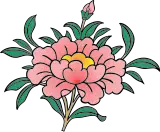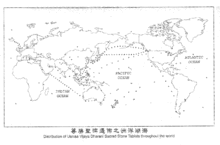Uṣṇīṣa Vijaya Dhāraṇī Sūtra
The Uṣṇīṣa Vijaya Dhāraṇī sūtra (Sanskrit; Chinese: 佛頂尊勝陀羅尼經; Japanese pronunciation: Butchō Sonshō Darani Kyō; Vietnamese: Phật Đỉnh Tôn Thắng Đà la ni) is a Mahayana sutra from India. An alternate longer Sanskrit title is the Sarvadurgatipariśodhana Uṣṇīṣa Vijaya Dhāraṇī sūtra.[1]
| Part of a series on |
| Buddhism |
|---|
 |
|
| Part of a series on |
| Mahāyāna Buddhism |
|---|
 |
History
The sutra was translated a total of eight times from Sanskrit to Chinese between 679-988 CE.[1] It gained wide circulation in China, and its practices have been utilized since the Tang dynasty, from which it then spread to the rest of East Asia. The Uṣṇīṣa Vijaya dhāraṇī is associated with Mount Wutai, which in the Chinese Buddhist tradition is considered the bodhimaṇḍa of Mañjuśrī. Sacred stone tablets with the Uṣṇīṣa Vijaya dhāraṇī carved into them have been distributed widely in some regions of the Far East.[2]
Contents
The purpose of this sūtra is said to be to help sentient beings in a troubled and tumultuous world. According to this sūtra, beings will leave suffering and obtain happiness, increasing in their prosperity and longevity, remove karmic obstacles, eliminate disasters and calamities, remove enmity and hatred, fulfill all wishes, and quickly be led onto the Buddha's way.[2] It is held by some that when the dhāraṇī is heard, it can imbue the alaya consciousness with pure seeds that will help to lead one to buddhahood. This mantra is also linked to Green Tara.
According to the text, major applications of this dhāraṇī include:[2]
- Destroy calamities and rescue those in difficulties
- Eliminate offenses and create good deeds
- Purify all karmic obstructions
- Increase blessings and lengthen lifespan
- Attain anuttarā-samyak-saṃbodhi
- Relieve beings in the ghost realm
- Benefit birds, animals and all crawling creatures
- Increase wisdom
- Revert the fixed karma;
- Eliminate various illness;
- Destroy hells;
- Ensure the safety of the households, and having children to inherit the family pride;
- Harmonise husbands and wives;
- Be able to reborn in Sukhavati or other pure lands;
- Heal sickness inflicted by pretas;
- Request for rain etc.
Some quotes from the sutra text include:
If someone hears this Dharani even just for a moment, he will not undergo karmic retribution from evil karma and severe hindrances accumulated from thousands of kalpas ago, that would otherwise cause him to revolve in the cycles of birth and death - in all kinds of life forms in the evil paths - hell, hungry ghost, animal, realm of King Yama, Asuras...ferocious animals, crawling creatures and even ants and other life forms...he will be reborn in the Buddhalands, together with all the Buddhas and Ekajati-pratibadda Bodhisattvas, or in a distinguished Brahmin or Ksatriya family, or in some other wealthy and reputable families.[2]

Sūtra
According to the Sūtra a devaputra by the name of Susthita was enjoying the supremely wonderful bliss of heavenly life. But then he suddenly heard a voice in space saying,
Devaputra Susthita, you have only seven days left to live. After death, you will be reborn in Jambudvipa (Earth) as an animal for seven successive lives. Then you will fall into the hells to undergo more sufferings. Only after fulfilling your karmic retribution will you be reborn in the human realm, but to a humble and destitute family; while in the mother’s womb you will be without eyes and be born blind.
On hearing this, Devaputra Susthita was so terrified and rushed over to the Heavenly Palace of Lord Sakra. Bursting into tears, he prostrated himself and telling what had happened to Lord Sakra. Lord Sakra immediately calmed his mind to enter Samadhi. Instantly, he saw that Susthita would undergo seven successive evil paths in the forms of a pig, dog, jackal, monkey, python, crow and vulture, all feeding on filth and putrescence. Lord Sakra could not think of any way to help Susthita. He felt that only the Tathagata, Arhat, Samyaksambuddha could save Susthita from falling into the great sufferings of evil destinies.
Soon after nightfall, Lord Sakra made preparation and head to the garden of Anathapindada. Upon arrival, Lord Sakra prostrated himself at the Buddha’s, then circumambulated the Buddha seven times clockwise in worship, before laying out this great Puja (offerings). Kneeling in front of the Buddha, Lord Sakra described the future destiny of Devaputra Susthita.
Instantly, the usnisa (crown of the head) of the Tathagata radiated multiple rays of light, illuminating the world in all ten directions—the light then returned. The Buddha smiled and said to Lord Sakra, “Lord of Heaven, there is a Dharani known as the Uṣṇīṣa Vijaya Dhāraṇī. It can purify all evil paths, completely eliminating all sufferings of beings in the realms of hell, King Yama and animal, destroy all the hells, and transfer sentient beings onto the virtuous path.” After hearing all the disclosure, Lord of Heaven appealed to the Buddha to discourse of this great Dharani. The Buddha aware of Lord Sakra’s intention and his eagerness to hear His discourse of this Dharani and so immediately proclaimed the Mantra. Then the Buddha told Lord Sakra, “The Mantra is known as the ‘Purifying All Evil Path’ Uṣṇīṣa Vijaya Dhāraṇī’. It can eliminate all evil karmic hindrances and eradicate the suffering of all evil paths.” Again the Buddha told Lord Sakra that this great Dharani is proclaimed together by Buddhas as numerous as eighty-eight kotis (hundred million) of the grains of sand of the Ganges River. All Buddhas rejoice and uphold this Dharani that is verified by the wisdom seal of the Vairocana Tathagata.
Again the Buddha reminded Lord Sakra should, in turn, transmit it to Devaputra Susthita and in addition, you yourself should receive and uphold it, recite, contemplate and treasure it, memorize and preserve it. This Dharani should be widely proclaimed to all beings in the Jambudvipa world and entrust him for the benefit of all heavenly beings. The Buddha also reminded Lord Sakra should diligently uphold and protect it, never letting it be forgotten or lost.
After the Lord Sakra received this Dharani practice from the Buddha, he returned to his heavenly palace to convey it to Devaputra Susthita. Having received this Dharani, Devaputra Susthita kept practices as instructed for six days and six nights, after which all his wishes were completely fulfilled.
When seven days were over, Lord Sakra brought Devaputra Susthita, together with other heavenly beings, respectfully approached the Buddha and presented their grand offerings. Once they have respectfully circumambulated a hundred thousand times, paid homage to the Buddha, then happily took their seats and listened to the Buddha preach the Dharma.
The World Honoured One then extended his golden arm and touch Devaputra Susthita to bestow a prediction of Devaputra Susthita's attainment to Bodhi.[2]
Mantra
Sanskrit
- namo bhagavate trailokya prativiśiṣṭaya buddhāya bhagavate.
- tadyathā, om, viśodhaya viśodhaya, asama-sama
- samantāvabhāsa-spharaṇa gati gahana svabhāva viśuddhe,
- abhiṣiñcatu mām. sugata vara vacana amṛta abhiṣekai mahā mantra-padai.
- āhara āhara āyuḥ saṃ-dhāraṇi. śodhaya śodhaya gagana viśuddhe.
- uṣṇīṣa vijaya viśuddhe sahasra-raśmi sam-codite.
- sarva tathāgata avalokani ṣaṭ-pāramitā-paripūraṇi.
- sarva tathāgata mati daśa-bhūmi prati-ṣṭhite.
- sarva tathāgata hṛdaya adhiṣṭhānādhiṣṭhita mahā-mudre.
- vajra kāya sam-hatana viśuddhe.
- sarva āvaraṇa apāya-durgati pari viśuddhe, prati-nivartaya āyuh śuddhe.
- samaya adhiṣṭhite. maṇi maṇi mahā maṇi.
- tathatā bhūta-koṭi pariśuddhe. visphuṭa buddhi śuddhe.
- jaya jaya, vijaya vijaya. smara smara, sarva buddha adhiṣṭhita śuddhe,
- vajri vajragārbhe vajram bhavatu mama śarīram.
- sarva sattvānām ca kāya pari viśuddhe. sarva gati pariśuddhe.
- sarva tathāgata siñca me samāśvāsayantu.
- sarva tathāgata samāśvāsa adhiṣṭhite.
- budhya budhya, vibudhya vibudhya,
- bodhaya bodhaya, vibodhaya vibodhaya samanta pariśuddhe.
- sarva tathāgata hṛdaya adhiṣṭhānādhiṣṭhita mahā-mudre svāhā.
This Uṣṇīṣa Vijaya Dhāraṇī includes several additions to the original Sanskrit transliteration, for completeness, and in light of other versions.
In addition to the long dhāraṇī, there is the much shorter Uṣṇīṣa Vijaya heart-mantra:
- oṃ amṛta-tejavati svāhā
Translation
The world-famous Japanese Zen scholar D.T. Suzuki translated the Uṣṇīṣa Vijaya Dhāraṇī into the English language and this was included in the Manual of Zen Buddhism.
Ten doors
According to the Records of the Teaching of Uṣṇīṣa Vijaya Dhāraṇī Sūtra by Great Dharma Master Fa Cong (in the Tang dynasty),[2] the great and unsurpassed merits of this Dharani can be categorised into ten doors as follows:
- The door of taking refuge under the sages.
- The door of revealing the Dharma Body.
- The door of purifying evil paths.
- The door of good and brightness initiation.
- The door of spiritual power protection.
- The door of lengthening the lifespan.
- The door of integrating concentration and wisdom.
- The door of Vajra offering.
- The door of universally attaining purity.
- The door of accomplishing Nirvana.
See also
Further reading
- F. Max Müller, Bunyiu Nanjio (1884). The ancient palm-leaves: containing the Pragna-paramita-hridaya-sutra and the Ushnisha-vigaya-dharani. Sanskrit and Japanese texts, edited and translated, with an appendix by G. Bühler, Anecdota Oxoniensia, Aryan series, III. Oxford: Clarendon Press. Reprint 1972
- Uṣṇīṣa Vijaya Dhāraṇī Sutra Chinese/English/Malay Translation by Malaysia Usnisa Vijaya Buddhist Association (Malay: Persatuan Penganut Agama Buddha Usnisa Vijaya Malaysia)
- Chandra, Lokesh (1980). Iconography of the Goddess Uṣṇīṣa Vijaya, Acta Orientalia Academiae Scientiarum Hungaricae 34 (1/3), 125-137
- Usnisa Vijaya Dharani Sutra(Chinese/English/Malay)
References
- "The Korean Buddhist Canon: A Descriptive Catalog (K 319)".
- Uṣṇīṣa Vijaya Dhāraṇī Sūtra (Chinese/English/Malay)
3. ^ Usnisa Vijaya Dharani Sutra(Chinese/English/Malay)
External links
| Sanskrit Wikisource has original text related to this article: |